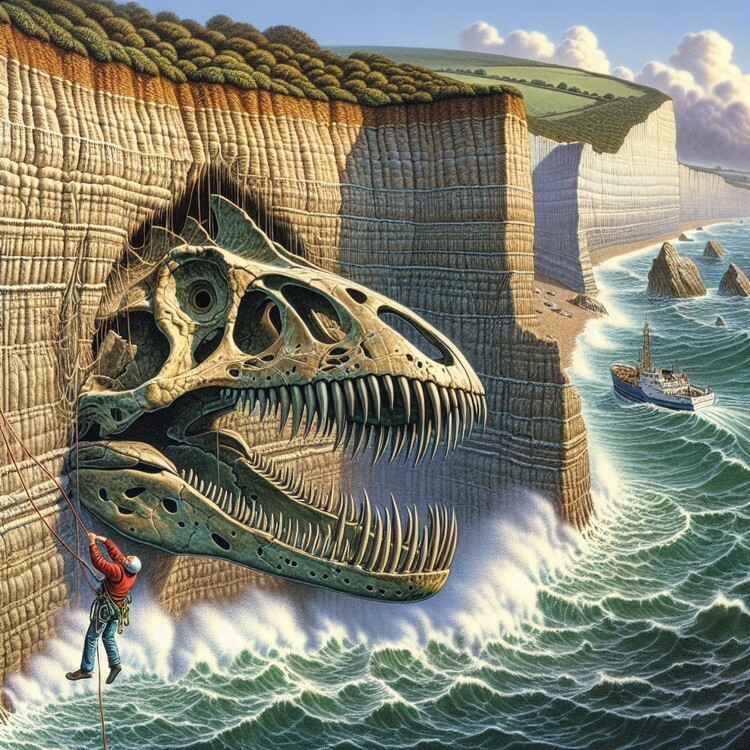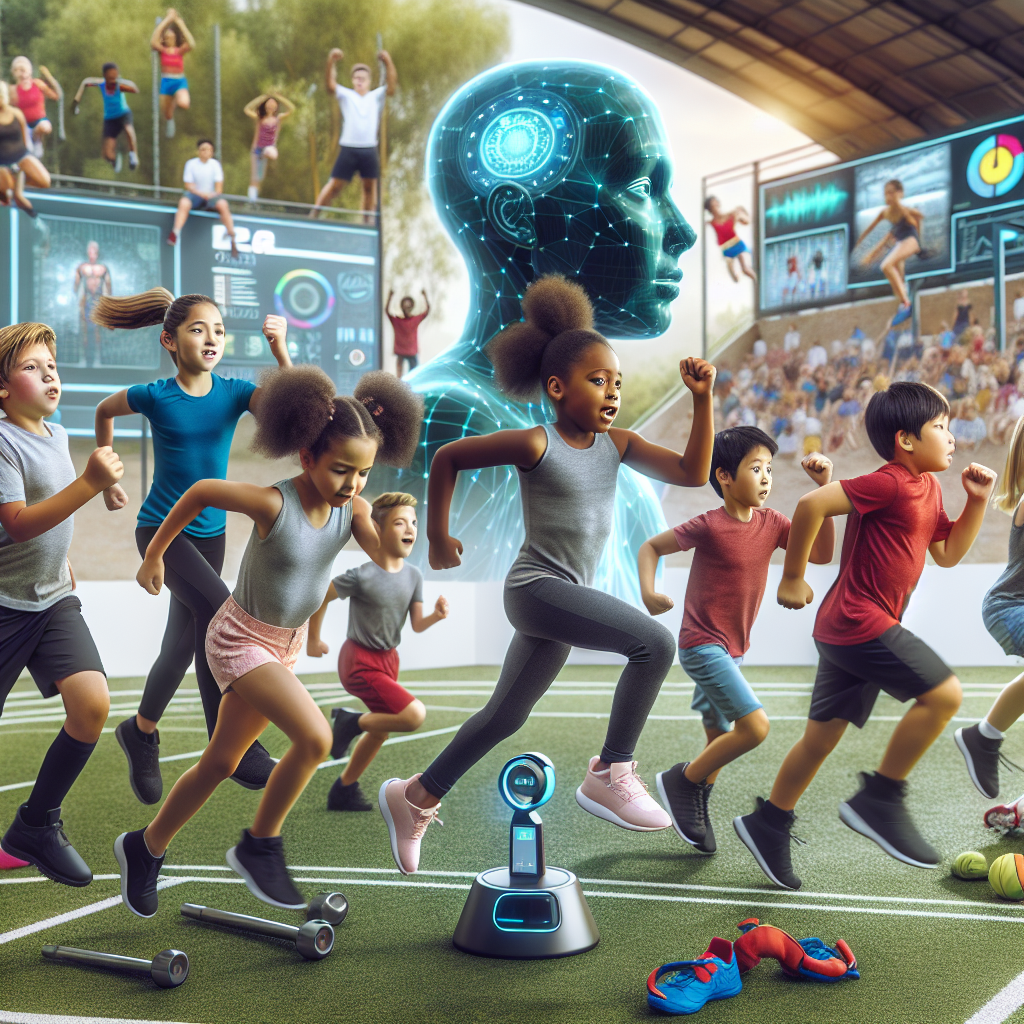A really cool discovery has been made on the Jurassic Coast in Dorset, England. They found the skull of a huge sea monster called a pliosaur. This pliosaur lived about 150 million years ago and was a scary predator of the oceans. The fossil is one of the most complete ones ever found, which is super helpful for scientists to learn about this ancient creature. They’re even going to show it in a special TV show with Sir David Attenborough on New Year’s Day.
The pliosaur skull is really impressive, it’s longer than the height of an average person. And it’s in really good condition, with every bone still there. That’s really rare for a fossil. The skull has 130 teeth, which were long and super sharp. They could deliver a really deadly bite. The back of each tooth has ridges that helped the pliosaur pierce flesh and quickly pull out its teeth for a second attack.
The pliosaur was a really strong predator, about 10-12 meters long, and it had powerful flipper-like limbs. It was the top predator in the ocean and could eat other big marine reptiles like plesiosaurs and ichthyosaurs. The fossil evidence even shows that pliosaurs might have eaten other pliosaurs. Finding this skull is a big deal for scientists because it helps them understand how these ancient reptiles lived and ruled their environment.
Finding the fossil skull was a really amazing thing. It started when a person who loves fossils found the tip of the pliosaur’s snout on a beach. The rest of the animal was on the cliff, so they had to do a daring climb down to get it out. It took months to clean and prepare the skull for study, but it was totally worth it because scientists from all over the world are excited to check it out.
The pliosaur skull also has some interesting features that suggest the creature had really good senses. There are small pits on its snout that might have had glands to help it sense changes in water pressure made by possible prey. And the pliosaur had a hole on its head that might have had a third eye, like lizards and some fish today. This eye could sense light and help the pliosaur find other animals, especially when it came up from deep, murky water.
The skull will be shown at a museum in Kimmeridge, Dorset, so people can see this amazing fossil. But there’s still hope that more of the pliosaur’s body is hidden in the cliffs. The cliffs are wearing away quickly, so it’s really important to find the rest of the animal before it’s gone forever. This discovery is a once-in-a-lifetime chance to learn more about these ancient sea monsters and how they fit into Earth’s history.
Original news source: Pliosaur discovery: Huge sea monster emerges from Dorset cliffs (BBC)
🎧 Listen:
Slow
Normal
Fast
📖 Vocabulary:
| 1 | discovery | Finding something that was not known before |
| 2 | predator | An animal that hunts and eats other animals |
| 3 | fossil | The remains of an animal or plant that lived a long time ago, now turned into rock |
| 4 | creature | A living thing, like an animal or a person |
| 5 | impressive | Something that is very big or amazing and makes people say “wow |
| 6 | ridges | Long, narrow raised parts, like on the back of a dinosaur or the edge of a coin |
| 7 | evidence | Proof or information that shows something is true |
| 8 | marine | Related to the sea or ocean, especially living in it |
| 9 | daring | Brave or adventurous, especially when doing something risky |
| 10 | senses | The abilities to see, hear, smell, taste, and feel |
| 11 | glands | Small organs in the body that make and release substances for various functions |
| 12 | murky | Dark and difficult to see through, often used to describe water or fog |
| 13 | museum | A place where important things from history are kept and shown to the public |
| 14 | cliffs | Steep rocks, usually by the sea or ocean, that can be dangerous |
| 15 | ancient | Very old, from a time long past, especially before the Middle Ages |
Group or Classroom Activities
Warm-up Activities:
– News Summary
Instructions:
1. Divide the class into pairs or small groups.
2. Give each group a few minutes to read the article.
3. Instruct the groups to collaboratively write a summary of the article, focusing on the main points and key details.
4. Have each group share their summary with the class.
– Word Association
Instructions:
1. Write the word “pliosaur” on the board.
2. Instruct the students to brainstorm and write down as many words as they can think of that are associated with pliosaurs.
3. After a few minutes, have the students share their word lists with the class.
4. Encourage discussion and explanation of the associations.
– Sketch It
Instructions:
1. Divide the class into pairs.
2. Give each pair a piece of paper and a pen or pencil.
3. Instruct one student in each pair to describe the pliosaur skull to their partner, while the partner sketches what they imagine it looks like based on the description.
4. After a few minutes, have the pairs compare their sketches to the actual image of the pliosaur skull.
5. Discuss the similarities and differences between the sketches and the actual skull.
– Vocabulary Pictionary
Instructions:
1. Write a selection of vocabulary words from the article on individual slips of paper.
2. Divide the class into small teams.
3. Have one student from each team pick a slip of paper and draw a picture that represents the word, without using any letters or numbers.
4. The other students on the team must guess the word based on the drawing.
5. Rotate turns until all the slips of paper have been used.
– Speed Summarizing
Instructions:
1. Divide the class into pairs.
2. Give each pair a set time limit, such as 1 minute.
3. Instruct one student in each pair to summarize the article to their partner within the time limit.
4. After the time is up, have the pairs switch roles and repeat.
5. Encourage the students to focus on the most important information and practice speaking fluently and concisely.
🤔 Comprehension Questions:
1. What was discovered on the Jurassic Coast in Dorset, England?
2. Why is the fossil of the pliosaur skull important for scientists?
3. How long was the pliosaur and what were its limbs like?
4. How did the pliosaur use its teeth to attack its prey?
5. How did the person who found the fossil skull on the beach manage to retrieve it?
6. What are some interesting features of the pliosaur skull that suggest it had good senses?
7. Where will the pliosaur skull be shown for people to see?
8. Why is it important to find the rest of the pliosaur’s body before it’s gone forever?
Go to answers ⇩
🎧✍️ Listen and Fill in the Gaps:
A really cool discovery has been made on the Jurassic Coast in Dorset, England. They found the skull of a huge sea monster called a (1)______. This pliosaur lived about 150 million years ago and was a scary predator of the oceans. The (2)______ is one of the most complete ones ever found, which is super helpful for scientists to learn about this ancient creature. They’re even (3)______ to show it in a special TV show with Sir David Attenborough on New Year’s Day.
The pliosaur skull is really impressive, it’s longer than the (4)______ of an average person. And it’s in really good condition, with every bone still there. That’s really rare for a fossil. The skull has 130 teeth, which were long and super sharp. They could deliver a really (5)______ bite. The back of each tooth has ridges that helped the pliosaur pierce flesh and quickly pull out its teeth for a second attack.
The pliosaur was a really strong (6)______, about 10-12 meters long, and it had powerful flipper-like limbs. It was the top predator in the ocean and could eat other big marine reptiles like plesiosaurs and ichthyosaurs. The fossil (7)______ even shows that (8)______ might have eaten other pliosaurs. Finding this skull is a big deal for scientists because it helps them understand how these ancient reptiles lived and ruled their environment.
Finding the fossil (9)______ was a really amazing thing. It started when a person who loves fossils found the tip of the pliosaur’s snout on a beach. The rest of the animal was on the cliff, so they had to do a daring climb down to get it out. It took (10)______ to clean and prepare the skull for study, but it was totally worth it because scientists from all over the world are excited to (11)______ it out.
The pliosaur skull also has some interesting features that (12)______ the creature had really good senses. There are small pits on its snout that might have had glands to help it sense changes in water pressure made by possible prey. And the pliosaur had a hole on its head that might have had a third eye, like lizards and some fish today. This eye could sense light and help the pliosaur find other animals, especially when it came up from deep, (13)______ water.
The skull will be shown at a museum in Kimmeridge, Dorset, so (14)______ can see this (15)______ fossil. But there’s still hope that more of the pliosaur’s body is hidden in the (16)______. The cliffs are wearing away quickly, so it’s really important to find the rest of the animal before it’s gone forever. This discovery is a once-in-a-lifetime chance to learn more about these ancient sea monsters and how they fit into Earth’s history.
Go to answers ⇩
💬 Discussion Questions:
Students can ask a partner these questions, or discuss them as a group.
1. Have you ever found something interesting or valuable? If so, what was it and how did you feel?
2. What do you think it would be like to discover a fossil? Why?
3. Do you think it’s important to study ancient creatures? Why or why not?
4. How do you think scientists can learn about ancient creatures from their fossils?
5. Have you ever watched a TV show with Sir David Attenborough? If so, what did you think of it? If not, would you like to watch one?
6. How do you think the pliosaur used its long, sharp teeth to catch its prey?
7. Why do you think the pliosaur was considered the top predator in the ocean?
8. If you were a scientist studying the pliosaur, what would you want to learn about it?
9. Have you ever climbed a cliff or done something daring? If so, what was it and how did you feel?
10. How do you think the pliosaur’s senses helped it survive in its environment?
11. Would you like to see the pliosaur skull at the museum in Kimmeridge? Why or why not?
12. How do you think the discovery of the pliosaur skull can help us understand Earth’s history?
13. Do you think it’s important to preserve fossils and other ancient artifacts? Why or why not?
14. If you could discover any ancient creature, what would it be and why?
15. How would you feel if you found the rest of the pliosaur’s body hidden in the cliffs? Why?
Individual Activities
📖💭 Vocabulary Meanings:
Match each word to its meaning.
Words:
1. discovery
2. predator
3. fossil
4. creature
5. impressive
6. ridges
7. evidence
8. marine
9. daring
10. senses
11. glands
12. murky
13. museum
14. cliffs
15. ancient
Meanings:
(A) The remains of an animal or plant that lived a long time ago, now turned into rock
(B) Small organs in the body that make and release substances for various functions
(C) Very old, from a time long past, especially before the Middle Ages
(D) Brave or adventurous, especially when doing something risky
(E) Dark and difficult to see through, often used to describe water or fog
(F) Steep rocks, usually by the sea or ocean, that can be dangerous
(G) Proof or information that shows something is true
(H) Related to the sea or ocean, especially living in it
(I) Long, narrow raised parts, like on the back of a dinosaur or the edge of a coin
(J) Something that is very big or amazing and makes people say “wow”
(K) Finding something that was not known before
(L) A living thing, like an animal or a person
(M) The abilities to see, hear, smell, taste, and feel
(N) An animal that hunts and eats other animals
(O) A place where important things from history are kept and shown to the public
Go to answers ⇩
🔡 Multiple Choice Questions:
1. What is the name of the sea monster skull that was discovered on the Jurassic Coast?
(a) Plesiosaur
(b) Ichthyosaur
(c) Pliosaur
(d) Megalodon
2. How old is the pliosaur skull?
(a) 100 million years old
(b) 50 million years old
(c) 150 million years old
(d) 10 million years old
3. What is special about the pliosaur skull that was found?
(a) It is one of the most complete fossils ever found
(b) It is the largest fossil ever found
(c) It is the oldest fossil ever found
(d) It is the smallest fossil ever found
4. How many teeth does the pliosaur skull have?
(a) 50 teeth
(b) 130 teeth
(c) 200 teeth
(d) 75 teeth
5. What did the pliosaur eat?
(a) Fish
(b) Plants
(c) Insects
(d) Other big marine reptiles
6. How long was the pliosaur?
(a) 10-12 meters long
(b) 5-7 meters long
(c) 15-20 meters long
(d) 2-4 meters long
7. What interesting features does the pliosaur skull have?
(a) Large fins and a long tail
(b) Sharp claws and a powerful bite
(c) A colorful pattern and a loud roar
(d) Small pits on its snout and a possible third eye
8. Where will the pliosaur skull be shown?
(a) A museum in London, England
(b) A museum in Kimmeridge, Dorset
(c) A museum in Paris, France
(d) A museum in New York, USA
Go to answers ⇩
🕵️ True or False Questions:
1. The pliosaur was a subordinate predator, measuring around 2-3 meters in length, and could not prey on other large marine reptiles.
2. The discovery of the skull is significant for scientists as it provides valuable insights into the lifestyle and behavior of these ancient reptiles.
3. A fragmented pliosaur skull, one of the least intact ever found, has been discovered on the Jurassic Coast in Dorset, England.
4. The skull is shorter than the height of an average person and is in poor condition, with some of its bones missing.
5. The back of each tooth had smooth surfaces that hindered the pliosaur from piercing flesh and rapidly retracting its teeth for a second attack.
6. The skull will be exhibited at a museum in Kimmeridge, Dorset, allowing people to marvel at this incredible fossil, while there is still hope of finding more of the pliosaur’s body in the rapidly eroding cliffs.
7. The pliosaur lived around 150 million years ago and was a fearsome predator of the oceans.
8. The pliosaur had 130 long and sharp teeth, capable of delivering a deadly bite.
Go to answers ⇩
📝 Write a Summary:
Write a summary of this news article in two sentences.
Check your writing now with the best free AI for English writing!
Writing Questions:
Answer the following questions. Write as much as you can for each answer.
Check your answers with our free English writing assistant!
1. What did scientists discover on the Jurassic Coast in Dorset, England?
2. Why is the discovery of the pliosaur skull important for scientists?
3. How long was the pliosaur and what made it a strong predator?
4. How did the person who found the pliosaur skull know that the rest of the animal was on the cliff?
5. What are some interesting features of the pliosaur skull that suggest it had good senses?
✅ Answers
🤔✅ Comprehension Question Answers:
1. What was discovered on the Jurassic Coast in Dorset, England?
A pliosaur skull was discovered on the Jurassic Coast in Dorset, England.
2. Why is the fossil of the pliosaur skull important for scientists?
The fossil of the pliosaur skull is important for scientists because it is one of the most complete ones ever found, which helps them learn more about this ancient creature and how it lived.
3. How long was the pliosaur and what were its limbs like?
The pliosaur was about 10-12 meters long and it had powerful flipper-like limbs.
4. How did the pliosaur use its teeth to attack its prey?
The pliosaur used its long and sharp teeth to deliver a deadly bite. The ridges on the back of each tooth helped it pierce flesh and quickly pull out its teeth for a second attack.
5. How did the person who found the fossil skull on the beach manage to retrieve it?
The person who found the fossil skull on the beach had to do a daring climb down the cliff to retrieve the rest of the animal.
6. What are some interesting features of the pliosaur skull that suggest it had good senses?
Some interesting features of the pliosaur skull that suggest it had good senses are small pits on its snout that might have had glands to help it sense changes in water pressure, and a hole on its head that might have had a third eye to sense light and help it find other animals.
7. Where will the pliosaur skull be shown for people to see?
The pliosaur skull will be shown at a museum in Kimmeridge, Dorset for people to see.
8. Why is it important to find the rest of the pliosaur’s body before it’s gone forever?
It is important to find the rest of the pliosaur’s body before it’s gone forever because the cliffs are wearing away quickly, and finding the rest of the animal will provide a once-in-a-lifetime chance to learn more about these ancient sea monsters and their place in Earth’s history.
Go back to questions ⇧
🎧✍️✅ Listen and Fill in the Gaps Answers:
(1) pliosaur
(2) fossil
(3) going
(4) height
(5) deadly
(6) predator
(7) evidence
(8) pliosaurs
(9) skull
(10) months
(11) check
(12) suggest
(13) murky
(14) people
(15) amazing
(16) cliffs
Go back to questions ⇧
📖💭✅ Vocabulary Meanings Answers:
1. discovery
Answer: (K) Finding something that was not known before
2. predator
Answer: (N) An animal that hunts and eats other animals
3. fossil
Answer: (A) The remains of an animal or plant that lived a long time ago, now turned into rock
4. creature
Answer: (L) A living thing, like an animal or a person
5. impressive
Answer: (J) Something that is very big or amazing and makes people say “wow”
6. ridges
Answer: (I) Long, narrow raised parts, like on the back of a dinosaur or the edge of a coin
7. evidence
Answer: (G) Proof or information that shows something is true
8. marine
Answer: (H) Related to the sea or ocean, especially living in it
9. daring
Answer: (D) Brave or adventurous, especially when doing something risky
10. senses
Answer: (M) The abilities to see, hear, smell, taste, and feel
11. glands
Answer: (B) Small organs in the body that make and release substances for various functions
12. murky
Answer: (E) Dark and difficult to see through, often used to describe water or fog
13. museum
Answer: (O) A place where important things from history are kept and shown to the public
14. cliffs
Answer: (F) Steep rocks, usually by the sea or ocean, that can be dangerous
15. ancient
Answer: (C) Very old, from a time long past, especially before the Middle Ages
Go back to questions ⇧
🔡✅ Multiple Choice Answers:
1. What is the name of the sea monster skull that was discovered on the Jurassic Coast?
Answer: (c) Pliosaur
2. How old is the pliosaur skull?
Answer: (c) 150 million years old
3. What is special about the pliosaur skull that was found?
Answer: (a) It is one of the most complete fossils ever found
4. How many teeth does the pliosaur skull have?
Answer: (b) 130 teeth
5. What did the pliosaur eat?
Answer: (d) Other big marine reptiles
6. How long was the pliosaur?
Answer: (a) 10-12 meters long
7. What interesting features does the pliosaur skull have?
Answer: (d) Small pits on its snout and a possible third eye
8. Where will the pliosaur skull be shown?
Answer: (b) A museum in Kimmeridge, Dorset
Go back to questions ⇧
🕵️✅ True or False Answers:
1. The pliosaur was a subordinate predator, measuring around 2-3 meters in length, and could not prey on other large marine reptiles. (Answer: False)
2. The discovery of the skull is significant for scientists as it provides valuable insights into the lifestyle and behavior of these ancient reptiles. (Answer: True)
3. A fragmented pliosaur skull, one of the least intact ever found, has been discovered on the Jurassic Coast in Dorset, England. (Answer: False)
4. The skull is shorter than the height of an average person and is in poor condition, with some of its bones missing. (Answer: False)
5. The back of each tooth had smooth surfaces that hindered the pliosaur from piercing flesh and rapidly retracting its teeth for a second attack. (Answer: False)
6. The skull will be exhibited at a museum in Kimmeridge, Dorset, allowing people to marvel at this incredible fossil, while there is still hope of finding more of the pliosaur’s body in the rapidly eroding cliffs. (Answer: True)
7. The pliosaur lived around 150 million years ago and was a fearsome predator of the oceans. (Answer: True)
8. The pliosaur had 130 long and sharp teeth, capable of delivering a deadly bite. (Answer: True)
Go back to questions ⇧













